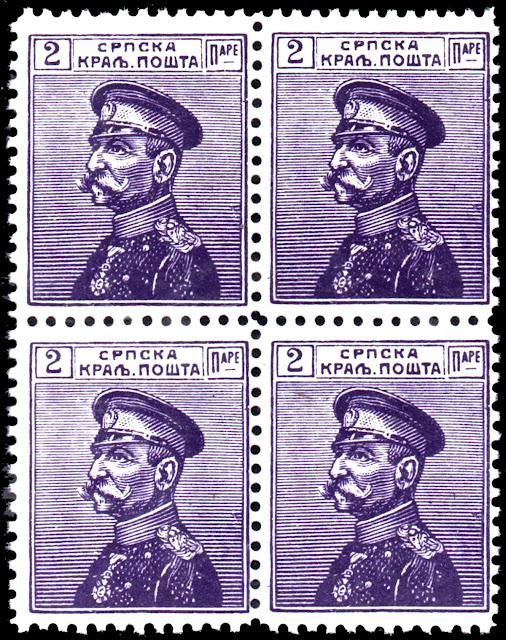The design was created by the French engraver Tasset, who also engraved the basic die in steel.
The cliches were also prepared in Paris, but the printing was done in Belgrade by the State Printing Works in typography.
The design measures 20 mm by 25.5 mm, the whole stamp, 23 mm by 27 mm.
The stamps were printed in two operations. The frames, in different colors, were done first, then the medallion in black.
They were printed in sheets of 100 (10 X 10).
During the six years they were in use, the stamps were reprinted several times (perhaps 6 times) using different papers and are found line perfed 11.5 and comb perfed 12X11.5. As well, the entire set can be found imperforated.
The following quantities of each value were printed:
1 para, 7,160,300
5 para, 28,404,200
10 para, 26,147,800
15 para, 2,409,100
20 para, 2,968,800
25 para, 4,721,800
30 para, 2,463,000
50 para, 3,244,800
1 dinar, 857,600
3 dinar, 177,400
5 dinar, 146,200
All values except the 3 and 5 dinar stamps were demonetized Feb. 9 1914. The 3 and 5 dinar were demonetized June 12 1914.
 |
| Genuine set |
 |
| Forgery set |
The dangerous forgery of the whole set surfaced after World War II.
The forgeries were made by Mirza Hadi who was of Persian origins and later became a stamp dealer in Paris and Monaco. He is best known for his involvement in the reprints of Transvaal stamps.
The forgeries are slightly larger. The original stamps measured, with perforations, 23 mm x 27 mm. The forgeries are 24 mm x 30 mm.
The paper used for the forgeries is not the same for all values. The 15 and 30 para forgeries are printed on slightly thinner paper.
The colors of the forgeries are much stronger than those of the genuine stamps, particularly in the 5 and 15 para and the I and 3 dinar values.
The gum used on the forgeries is entirely different from the gum on the genuine stamps.
They are printed by lithography, the genuine by typography.
Fortunately the Hadi stamps all have a very easily identified flaw
The upper right corner has a break in the frame
The upper right corner has a break in the frame
Another good method is to check the ends of the letters and numerals. In the originals (left) they have flat ends. In the forgeries (right) they are rounded
Based on my research, finding any genuine sets is a daunting effort
Almost all full and partial sets are forgeries
Given how well done they are, most dealers and sellers are not aware.
 |
| Rare genuine pair |
 |
| Proofs - genuine left, Hadi right |
 |
| Genuine Block |
 |
| Forgery Block |
The design was prepared by M. Markovich, a lithographer employed by the General Staff of the Army.
The die for it was cut in wood by P. Anicich, an employee of the State Printing Works.
They were printed in two panes in sheets of 100 (5 X 10)
The design measures 19.75 mm by 25.5 mm
The only constant plate flaw is a deformed numeral 1 on the 1 dinar stamp and it appears only once in each sheet of 100.
Genuine stamps from the first vertical row often have a double perforation on the left side.
Colors
I para, olive black
2 para, deep violet (first printing) and black violet (second printing)
5 para, yellow green
10 para, red carmine
15 para, purple
20 para, yellow
25 para, blue
30 para, blue green
50 para, grey brown
1 dinar, red orange
3 dinar, lake
5 dinar, violet
I para, olive black
2 para, deep violet (first printing) and black violet (second printing)
5 para, yellow green
10 para, red carmine
15 para, purple
20 para, yellow
25 para, blue
30 para, blue green
50 para, grey brown
1 dinar, red orange
3 dinar, lake
5 dinar, violet
Genuine and Forgery Features
There are 2 common "types" of forgeries
Overall very few line breaks
1. Both vertical lines have breaks
1. Both vertical lines have breaks
2. the outer frame is thick
3. The dashes on the uniform are organized and not random
4. The crease line is thin
Forgery Type I middle
1. The P is above the other letters. All the letters are smaller than the original.
2. There are breaks in the frame lines that are not as uniform
3. The vertical line is generally only broken on the left one.
4. The outer line is thick but not uniform all around
5. Large white area
6. The line is thicker than the original
Forgery Type II right
1. The lines are broken in several spots and uneven in thickness
2. The letters are smaller than the original
3. The outer line is thin
 |
| Type II forgery |
 |
| Type I forgery |
 |
| Type II forgery |
 |
| Type I forgery |
 |
| Type II forgery |
 |
| From the Fournier collection |
Type I forgery blocks commonly found in auctions with high values











No comments:
Post a Comment
THANK YOU for the feedback. Your comment will be reviewed and appear on this blog within 24 hours
Do you have any pic to share? Use this code [img]your-image-url-here[/img]